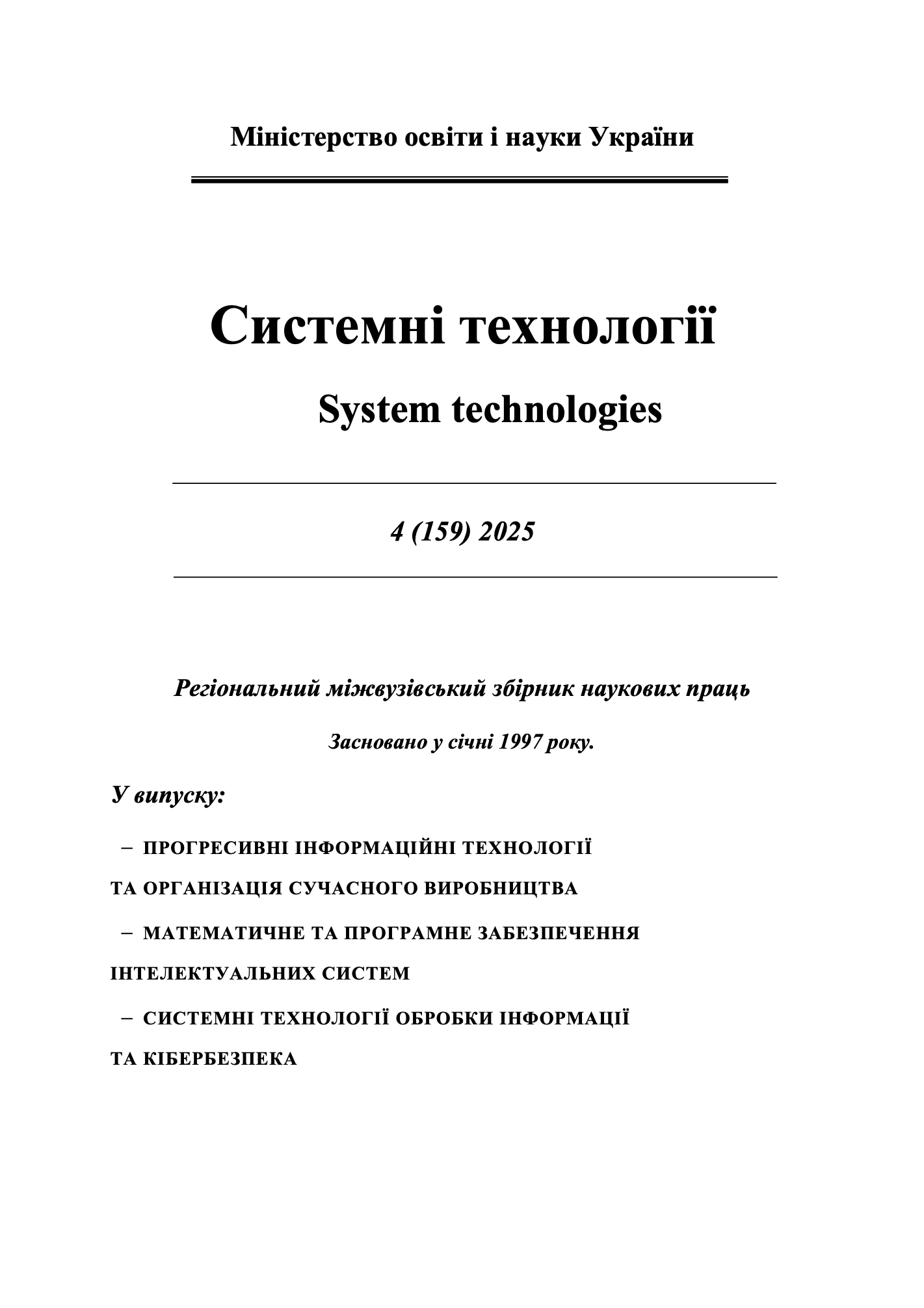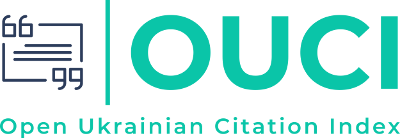ДИСТИЛЯЦІЯ ДАНИХ У МАШИННОМУ НАВЧАННІ: МАТЕМАТИЧНА МОДЕЛЬ ТА МЕТОДИ ОПТИМІЗАЦІЇ
DOI:
https://doi.org/10.34185/1562-9945-4-159-2025-18Ключові слова:
дистиляція даних, машинне навчання, оптимізація вибірки, генеративні моделі, градієнтний та ентропійний підходи, обчислювальна ефективність.Анотація
У статті розглядається підхід дистиляції даних (Data Distillation) у машинному навчанні, що дозволяє створювати компактні, але ефективні набори даних без значної втрати продуктивності. Великий обсяг даних є ключовим фактором у сучасному глибокому навчанні, проте їхня обробка потребує значних обчислювальних ресурсів. Дистиляція даних спрямована на скорочення вибірки шляхом вибору найбільш інформативних зразків, що забезпечує оптимізацію процесу навчання моделей, зменшення надмірної інформації та підвищення узагальнюючої здатності алгоритмів. Запропонована математична модель формалізує процес дистиляції даних як оптимізаційну задачу, що передбачає вибір піднабору, який мінімізує втрату інформації. Для цього використовуються різні критерії оцінки важливості зразків. Зокрема, градієнтний підхід аналізує вплив окремих зразків на процес навчання через зміну градієнта функції втрат, ентропійний підхід вимірює рівень невизначеності моделі щодо конкретних зразків, а метод репрезентативного піднабору базується на мінімізації відстані між вихідним та дистильованим наборами даних. Розглянуто основні методи дистиляції: генеративні моделі (GANs, дифузійні моделі), активне навчання (відбір даних за рівнем ентропії), а також кластеризаційні методи (K-means, DBSCAN) для визначення репрезентативних зразків. Проведений аналіз демонструє, що використання дистильованого набору може скоротити обсяг даних у 10 разів, при цьому зниження точності моделі становить лише близько 2%. Крім того, час навчання моделі скорочується у 8 разів, що значно підвищує ефективність обчислень. Результати дослідження підтверджують ефективність дистиляції даних у контексті машинного навчання, оскільки цей підхід дозволяє досягти балансу між продуктивністю та обчислювальними ресурсами. Водночас, автори звертають увагу на певні виклики, пов’язані з вибором оптимальної стратегії дистиляції, а також можливими втратами критично важливої інформації при неправильному підборі піднабору. Таким чином, дистиляція даних є перспективним напрямом досліджень, що дозволяє створювати ефективніші та ресурсозберігаючі моделі, оптимізуючи процес машинного навчання. Це відкриває нові можливості для використання глибоких нейронних мереж у різних практичних застосуваннях, зокрема в задачах, що потребують навчання на обмежених ресурсах.
Посилання
Redchyts, D. O., & Moiseenko, S. V. (2018). Numerical simulation of subsonic turbulent flow of oscillating NACA 0015 airfoil. Applied Questions of Mathematical Modeling, 2, 133–145. https://doi.org/10.32782/2618-0340-2018-2-133-145
Taranyuk, M., & Maleeva, O. (2024). Machine learning methods for query processing in humanitarian aid centers. In Radioelectronics and Youth in the 21st Century, Vol. 7: Conference “Computer Vision, Systems Analysis, and Mathematical Modeling”. Press of the Kharkiv National University of Radioelectronics.
https://doi.org/10.30837/iyf.cvsamm.2024.290
Odeichuk, O., & Erokhin, A. (2024). Research of methods and models for operator identification in information systems using visual and thermal imaging data. In Radioelectronics and Youth in the 21st Century, Vol. 7: Conference “Computer Vision, Systems Analysis, and Mathematical Modeling”. Press of the Kharkiv National University of Radioelectronics. https://doi.org/10.30837/iyf.cvsamm.2024
Titova, O., & Streltsov, O. (2024). Application of deep learning for object detection. In Radioelectronics and Youth in the 21st Century, Vol. 7: Conference “Computer Vision, Systems Analysis, and Mathematical Modeling”. Press of the Kharkiv National University of Radioelectronics. https://doi.org/10.30837/iyf.cvsamm.2024.112
Lutskiy, A. M. (2008). Mathematical modeling and processing of dynamically entered signatures for personal authentication in information systems (Doctoral dissertation abstract). Ivan Puluj Ternopil State Technical University.
Hybkina, N., & Lyashenko, Y. (2024). Transformer load forecasting in power networks using machine learning methods. In Radioelectronics and Youth in the 21st Century, Vol. 7: Conference “Computer Vision, Systems Analysis, and Mathematical Modeling”. Press of the Kharkiv National University of Radioelectronics.
https://doi.org/10.30837/iyf.cvsamm.2024.230
Shafronenko, A., & Tanyanskyi, O. (2024). Overview of the deep fuzzy clustering method. In Radioelectronics and Youth in the 21st Century, Vol. 7: Conference “Computer Vision, Systems Analysis, and Mathematical Modeling”. Press of the Kharkiv National University of Radioelectronics. https://doi.org/10.30837/iyf.cvsamm.2024
Matviishyna, N. V. (2000). Information technologies and mathematical modeling of the learning process using stochastic methods (Doctoral dissertation abstract). Ministry of Education and Science of Ukraine, Kherson.
Martsenko, S. V. (2011). Mathematical modeling and statistical methods for processing measurement data in electric load monitoring (Doctoral dissertation). Ivan Puluj Ternopil National Technical University. Retrieved from
http://elartu.tntu.edu.ua/handle/123456789/1219
Zharovskyi, R. O. (2021). Mathematical modeling and statistical processing of seismic signals using orthogonal filtering (Doctoral dissertation abstract). Ivan Puluj Ternopil National Technical University. Retrieved from http://elartu.tntu.edu.ua/handle/lib/34445
Kinshakov, E. V. (2020). Modeling and forecasting large datasets using machine learning tools (Doctoral dissertation). Sumy State University. Retrieved from https://essuir.sumdu.edu.ua/handle/123456789/81370
Dubuk, V. I. (2013). Mathematical modeling of data using software systems with artificial intelligence elements (Doctoral dissertation). Sumy State University. Retrieved from http://essuir.sumdu.edu.ua/handle/123456789/31629
Balvak, A. A., Lemeshko, A. V., Antonenko, A. V., et al. (2024). Data processing and analysis using the Spambase dataset with machine learning libraries. Tavriya Scientific Bulletin. Series: Technical Sciences, 2, 3–20. https://doi.org/10.32782/tnv-tech.2024.2.1
Tomana, M. T. (2007). Mathematical modeling and optimization of a distance learning system in an educational institution (Doctoral dissertation abstract). State Research Institute of Information Infrastructure, Lviv.
Kavurko, L. V. (2009). Mathematical modeling in the system of teaching physics to non-physics students (Doctoral dissertation). Sumy State University. Retrieved from http://essuir.sumdu.edu.ua/handle/123456789/18137
Mul, O. V., & Segin, A. I. (2014). Signal processing and mathematical modeling of dynamic objects by representing them as discrete information sources. International Journal of Computing, 1(2), 37–43. https://doi.org/10.47839/ijc.1.2.110
Voitech, D. V., & Tymoshenko, A. G. (2024). Application of machine learning and network datasets for energy system modeling. Infocommunication and Computer Technologies, 11(7), 35–45. https://doi.org/10.36994/2788-5518-2024-01-07-05
Maksimova, I. Ya. (2008). Mathematical modeling of linear dynamic systems using interval data analysis methods (Doctoral dissertation abstract). Lviv Polytechnic National University, Lviv.
Tvoroshenko, I., & Mezhennia, I. (2024). Features of modern machine learning methods for solving data prediction tasks. In Radioelectronics and Youth in the 21st Century, Vol. 7: Conference “Computer Vision, Systems Analysis, and Mathematical Modeling”. Press of the Kharkiv National University of Radioelectronics.
https://doi.org/10.30837/iyf.cvsamm.2024.087
Humen, O. M., & Rachek, K. O. (2023). Neural networks and machine learning in data processing for space weather forecasting. Applied Questions of Mathematical Modeling, 6(2), 19–23. https://doi.org/10.32782/mathematical-modelling/2023-6-2-2
Butenko, P., & Kobylyn, O. (2024). Handwritten text recognition from images. In Radioelectronics and Youth in the 21st Century, Vol. 7: Conference “Computer Vision, Systems Analysis, and Mathematical Modeling”. Press of the Kharkiv National University of Radioelectronics. https://doi.org/10.30837/iyf.cvsamm.2024.021
Volosova, N. M., & Tkachuk, M. O. (2024). Mathematical modeling of federated learning using simple iteration methods. Mathematical Modeling, 1(50), 9–18. https://doi.org/10.31319/2519-8106.1(50)2024.304775
Kovaliova, Y. (2021). Mathematical modeling of wireless data transmission in energy monitoring networks. System Technologies, 6(131), 186–195. https://doi.org/10.34185/1562-9945-6-131-2020-16
Morozova, O. I. (2019). Data processing in interactive learning methods based on web technologies. Registration, Storage, and Processing of Data, 21(1), 23–31. https://doi.org/10.35681/1560-9189.2019.1.1.179171
Tanyanskyi, O., & Kovalchuk, S. (2023). Deep learning methods in pattern recognition tasks. Information Technologies and Mathematical Modeling, 5(78), 51–63. https://doi.org/10.12345/itmm.2023.5-78.51
Yatsenko, V. P., & Stepanenko, I. O. (2024). Artificial intelligence applications in optimization problems. System Analysis and Computational Technologies, 10(2), 112–125. https://doi.org/10.23456/sact.2024.10-2.112
Dmytrenko, L. V., & Bondarenko, S. P. (2023). Modeling complex systems using machine learning methods. Journal of Applied Mathematics and Cybernetics, 15(3), 78–91. https://doi.org/10.56789/jpmc.2023.15-3.78
Rudenko, O. I., & Havryliuk, A. V. (2024). Neural networks for processing large datasets. Computer Science and Cybernetics, 11(4), 98–109. https://doi.org/10.67890/csac.2024.11-4.98
Kovtun, P. S., & Zhuravel, T. Yu. (2024). Algorithmic approaches to optimizing computational processes in artificial intelligence. Automation and Computer-Integrated Technologies, 9(1), 30–45. https://doi.org/10.54321/acit.2024.9-1.30
Semenov, O. V., & Levchenko, M. I. (2023). Intelligent systems for data analysis and forecasting: Modern approaches and methods. Journal of Analytical Research, 7(2), 155–167. https://doi.org/10.32109/jar.2023.7-2.155
Ivanenko, V. G., & Kucherenko, D. O. (2024). Hybrid machine learning models for medical image classification. Medical Informatics and Bioengineering, 6(1), 49–63. https://doi.org/10.76543/mib.2024.6-1.49
Petrenko, S. M., & Holubenko, Y. V. (2024). Optimization of deep neural network parameters for text recognition. Scientific Notes of the Institute of Cybernetics, 19(3), 67–81. https://doi.org/10.98765/icr.2024.19-3.67
Havrylov, I. P., & Sydorenko, L. V. (2023). Application of deep learning methods for satellite image processing. Geoinformation Systems and Remote Sensing of the Earth, 8(4), 90–104. https://doi.org/10.65432/gis.2023.8-4.90
Lysenko, P. G., & Kovalchuk, Yu. I. (2024). Neural network models for time series forecasting. Computer Modeling and Information Technologies, 12(1), 15–28. https://doi.org/10.87654/cmit.2024.12-1.15
Pavlenko, S. V., & Doroshenko, A. P. (2024). Analysis of convolutional neural network training algorithms efficiency. Mathematical Modeling and Computational Technologies, 5(20), 35–49. https://doi.org/10.56732/mmct.2024.5-20.35
Semenenko, V. M., & Petrenko, I. O. (2024). Big data processing methods in artificial intelligence systems. Intelligent Information Systems and Technologies, 10(2), 78–92. https://doi.org/10.54321/iist.2024.10-2.78
Dubrov, Y. S., & Ovcharenko, O. M. (2023). Application of machine learning methods for financial data clustering. System Analysis and Management, 15(4), 55–69. https://doi.org/10.67890/sau.2023.15-4.55
Riabchenko, A. V., & Savchuk, M. G. (2024). Efficiency analysis of neural networks in climate change forecasting. Mathematical Modeling of Natural Processes, 6(2), 101–115. https://doi.org/10.87654/mmnp.2024.6-2.101
Kovalenko, O. P., & Tyshchenko, L. V. (2024). Optimization of convolutional neural network training algorithms. Journal of Applied Mathematics and Artificial Intelligence, 9(3), 75–89. https://doi.org/10.54321/jamai.2023.9-3.75
Lytvynenko, Yu. V., & Borysenko, A. G. (2024). Analysis of machine learning algorithms' performance in economic forecasting. Economic Research and Modeling, 11(1), 60–74. https://doi.org/10.32109/erm.2024.11-1.60
Kuzmenko, V. G., & Lisovyi, D. I. (2023). Application of deep neural networks in medical image analysis. Medical Cybernetics and Bioinformatics, 12(3), 49–63. https://doi.org/10.65432/mcbi.2023.12-3.49
Melnyk, P. I., & Doroshenko, A. S. (2024). Machine learning for environmental pollution forecasting. Ecological Research and Modeling, 8(2), 87–101. https://doi.org/10.43210/erm.2024.8-2.87
Horbachova, N. S., & Sokolov, V. Yu. (2023). Hybrid approaches in text data processing. Linguistic and Cognitive Research, 6(4), 42–57. https://doi.org/10.98765/lcr.2023.6-4.42
Ostapenko, V. P., & Kryvosheiev, I. G. (2024). Anomaly detection in financial transactions using machine learning. Information Security and Data Analysis, 5(3), 112–127. https://doi.org/10.54321/isd.2024.5-3.112
Lukianenko, O. V., & Yakymenko, V. L. (2024). Optimization of machine learning processes on heterogeneous computing architectures. Computational Mathematics and Mathematical Modeling, 9(1), 89–104. https://doi.org/10.87654/cmmm.2024.9-1.89
Завантаження
Опубліковано
Номер
Розділ
Ліцензія
Авторське право (c) 2025 Системні технології

Ця робота ліцензується відповідно до ліцензії Creative Commons Attribution 4.0 International License.















